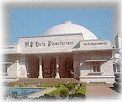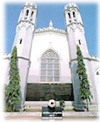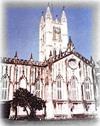
|

|
Birla Planetarium
 This planetarium is the largest
planetarium in Southeast Asia and the 2nd. largest planetarium
in the world. The planetarium was opened in 1961 and the cost of
completion came to about 2 crores. The capacity of the auditorium is 500
and there are daily film shows.
This planetarium is the largest
planetarium in Southeast Asia and the 2nd. largest planetarium
in the world. The planetarium was opened in 1961 and the cost of
completion came to about 2 crores. The capacity of the auditorium is 500
and there are daily film shows.
|

|
Nehru Children’s Museum
This small museum is worth visiting
for its clay models depicting the Hindu epics, the Ramayana and
the Mahabharata. It’s open daily except Monday from 11.30 a.m.
to 8.30 p.m.
|

|
Zoo & Horticultural Gardens
Calcutta zoo was opened in 1875. Some
of the animals are displayed in near natural environments. This
is the largest zoo in India. It comprises several animals, birds
and even creatures of rare species. The 'White Tiger', an almost extinct
race, is the chief attraction of the zoo.
|

|
Kali Temple
Rebuilt in 1809 on the site of
a much older temple on the bank of adi Ganga by Santosh Roy, descendant
of the Subarna Roy Chowdhury family, the local zamindar. The present
temple reflects the traditional Bengali architecture, Athchala
or eight roofed.
|

|
Dakshineswar Kali Temple
 The temple stands
solemnly on the bank of river Ganges. Sri Ramkrsihna reached his spiritual
vision of the unity of all religions in this sacrosanct place. The
temple was built in 1847.
The temple stands
solemnly on the bank of river Ganges. Sri Ramkrsihna reached his spiritual
vision of the unity of all religions in this sacrosanct place. The
temple was built in 1847.
|

|
 Botanical
Gardens
Botanical
Gardens
The gardens was founded in 1786 and
initially administered by Colonel Kyd of East India Company. The
gardens’ prime attraction is the 200-year old banyan tree, claimed
to have the second largest canopy in the world.
|

|
Shahid Minar
 It was erected in
1828 and named after Sir David Ochterlony, who is credited with winning
the Nepal War in 1814. The column is an intriguing combination of
Turkish, Egyptian and Syrian architectural elements.
It was erected in
1828 and named after Sir David Ochterlony, who is credited with winning
the Nepal War in 1814. The column is an intriguing combination of
Turkish, Egyptian and Syrian architectural elements.
|

|
 Fort William
Fort William
The establishment of Fort Williams
in 1696 marked the birth of a new city, Calcutta.
In 1756 the fort was taken by the Nawab
of Bengal, Siraj-ud-dullah. In 1757 East India Company regained their
power and demolished this fort and they started reconstruction of
the fort. The new fort was completed in 1773 and it is still there.
|

|
St Paul’s Cathedral
 Built around 1840, St Paul’s
Cathedral is counted among the old churches of India. The church
was redesigned and rebuilt after is suffered from the two earthquakes
in the 1897 and 1934.
Built around 1840, St Paul’s
Cathedral is counted among the old churches of India. The church
was redesigned and rebuilt after is suffered from the two earthquakes
in the 1897 and 1934.

|

|
Vidyasagar
Setu
 A modern day engineering
marvel, linking the twin city Calcutta to Howrah. This impressive cable
stayed bridge provides an alternative to the Howrah Bridge.
A modern day engineering
marvel, linking the twin city Calcutta to Howrah. This impressive cable
stayed bridge provides an alternative to the Howrah Bridge.
|

|
The Indian Museum
 Founded in 1814 by a Danish
botanist Nathaniel Wallich, also known as the Jadughar. The museum
is built in Italian architectural style and is considered as the
largest museum in the country and one of the best in Asia.
Founded in 1814 by a Danish
botanist Nathaniel Wallich, also known as the Jadughar. The museum
is built in Italian architectural style and is considered as the
largest museum in the country and one of the best in Asia.
|

|
Science City
 This complex is a must
see location with convention center, space theatre and excellent
science exhibits. The first and only institution of its kind in India
This complex is a must
see location with convention center, space theatre and excellent
science exhibits. The first and only institution of its kind in India
|

|
Victoria Memorial
 A splendid example of British
architecture, this building was built in memory of Queen Victoria
and was inaugurated by Prince of Wales in 1921. The Memorial is
based on architecture of the Taj and is built in marble.
A splendid example of British
architecture, this building was built in memory of Queen Victoria
and was inaugurated by Prince of Wales in 1921. The Memorial is
based on architecture of the Taj and is built in marble.

|

|
Nicco Park
 A small theme park located
in Saltlake. A place where people of all ages can enjoy their
day in various enthralling rides available.
A small theme park located
in Saltlake. A place where people of all ages can enjoy their
day in various enthralling rides available.
|

|
Jorasanko Thakurbari
The great poet Rabindranath
Tagore was born and died in this house. Prince Dwarkanath Tagore,
Rabindranath’s grandfather, built it in the 18th century.
|

|
Howrah Bridge
 Gateway of Kolkata- Howrah
Bridge has become a symbolic for Kolkata. The cantilever bridge
inaugurated in 1942 is 97 meters high and 705 meters long. The
world’s busiest bridge connects the Howrah to the central Kolkata.
Gateway of Kolkata- Howrah
Bridge has become a symbolic for Kolkata. The cantilever bridge
inaugurated in 1942 is 97 meters high and 705 meters long. The
world’s busiest bridge connects the Howrah to the central Kolkata.
|
